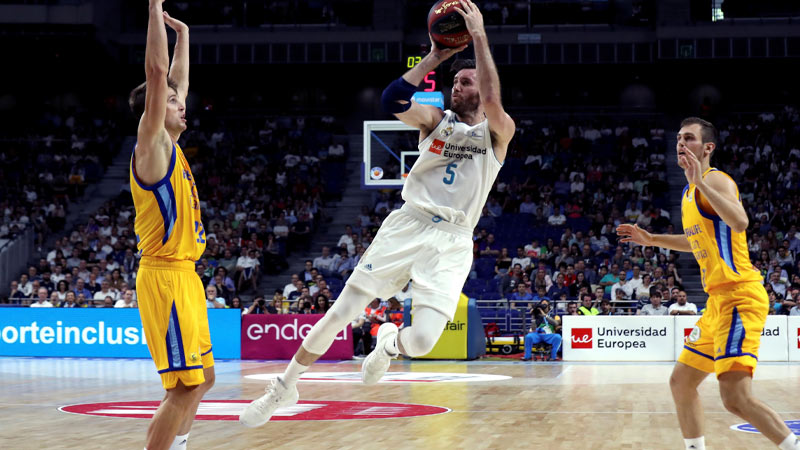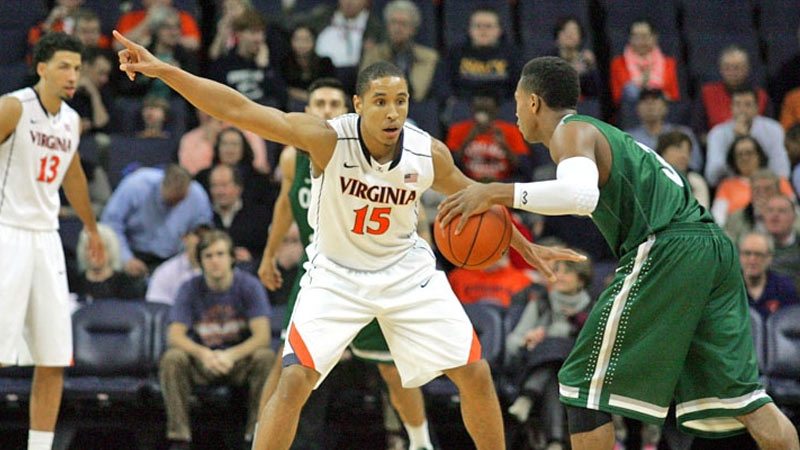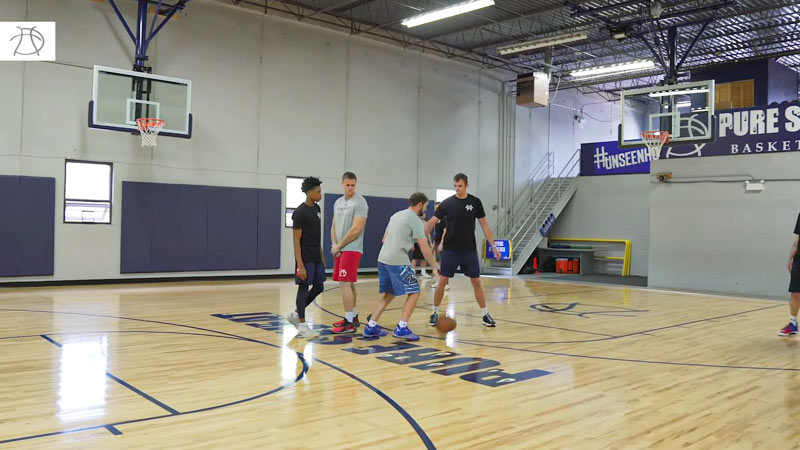In the game of basketball, offensive strategies play a pivotal role in creating scoring opportunities and outsmarting the defense.
One such strategy is the down screen, a fundamental maneuver that involves a player setting a screen to free a teammate for a scoring opportunity.
In this comprehensive guide, we will explore the intricacies of the down screen in basketball, including its various forms such as the pin-down screen and the down ball screen.
We will delve into the techniques, movements, and roles of players involved in executing and countering the down screen, highlighting its significance in creating effective ball movement and scoring opportunities.
What Is a Down Screen in Basketball?
A down screen is a fundamental offensive tactic employed in basketball to create scoring opportunities and facilitate effective ball movement.
It involves an off-ball player setting a screen on a defender, allowing a teammate to move down toward the basket or create separation for a jump shot.
The down screen is a strategic maneuver that aims to impede the defender’s movement and create space for the offensive player to exploit.
When executing a down screen, the screener positions themselves at a slight angle, with their body oriented toward the intended direction of the teammate.
This positioning ensures that the screener creates maximum interference with the defender’s path, making it more challenging for them to navigate the screen effectively.
The screener must also maintain proper spacing to prevent illegal contact or offensive fouls.
The objective of a down screen is to create opportunities for the offensive player to receive the ball in a favorable scoring position.
The teammate utilizing the screen can either cut toward the basket for an easy scoring opportunity or use the separation created by the screen to catch and shoot from mid-range or beyond the three-point line.
What is the Pin Down Screen?

Source:team.fastmodelsports.com
The pin-down screen is a specific type of down screen that is commonly employed near the baseline or low block area. In this variation, the screener sets the screen with the purpose of freeing up a teammate for a jump shot.
The pin-down screen is often used for shooters who excel in catch-and-shoot situations, as it allows them to quickly receive the ball in a favorable scoring position.
The pin-down screen involves the screener positioning themselves near the baseline or low block, and the teammate utilizing the screen by curling around it or popping out to the perimeter.
This action creates separation between the shooter and the defender, providing a window of opportunity for a clean catch and shoot.
The pin-down screen is an effective offensive tactic as it allows shooters to capitalize on their shooting prowess. By utilizing the screen effectively, shooters can create the necessary space to get off a high-percentage shot.
Additionally, the pin-down screen can cause defensive confusion and force opponents to make quick decisions, opening up opportunities for other offensive players as well.
How to Execute a Down Ball Screen in Basketball?
Executing a down ball screen requires coordination and communication between the ball handler and the screener. Here is a step-by-step breakdown of how to execute a down ball screen effectively:
Communication and Timing
The ball handler and screener must communicate their intentions and establish proper timing.
The ball handler should communicate their intention to use the screen, while the screener should be ready to set a solid screen at the right moment.
Proper Positioning
The screener should position themselves in a manner that creates the best advantage for the ball handler.
This typically involves standing slightly to the side of the defender guarding the ball handler, allowing the ball handler to dribble toward the screen.
Solid Screen
As the ball handler approaches the screen, the screener must quickly establish a solid screen by getting low and extending their arms.
It is crucial for the screener to maintain legal positioning and avoid moving while setting the screen to prevent offensive fouls.
Read the Defense
The ball handler must read the defense’s reaction to the screen. If the defender tries to go under the screen, the ball handler can pull up for a jump shot. If the defender fights over the screen, the ball handler can use the screen to drive to the basket.
The ball handler should also be aware of potential help defenders and passing lanes to make the right decision.
Offensive Options
Based on the defense’s reaction, the ball handler has several offensive options. They can drive to the basket for a layup or a dunk, pull up for a mid-range or three-point shot, or make a pass to an open teammate who may have been created by the screen.
Rolling or Popping
After setting the screen, the screener has two options: rolling to the basket or popping out for a shot. The screener should read the defense and make the appropriate decision.
Rolling to the basket creates a potential scoring opportunity near the rim while popping out allows for a potential jump shot if the defense collapses on the ball handler.
Quick Decision-Making
Both the ball handler and the screener must make quick decisions based on the defense’s reaction to the screen. This requires good court awareness, reading the defense, and reacting accordingly to exploit any defensive vulnerabilities.
By effectively executing a down ball screen, teams can create offensive advantages, force defensive rotations, and open up scoring opportunities for the ball handler or other teammates.
Proper communication, timing, positioning, and decision-making are vital in successfully executing this offensive play in basketball.
Movement in the Down Ball Screen in Basketball

Source: basketballhq.com
In basketball, the down ball screen refers to an offensive play where a player sets a screen for the ball handler near the baseline or low post area.
The movement and actions surrounding the down ball screen play a crucial role in creating scoring opportunities. Here are the typical movements involved in the down ball screen:
Ball Handler’s Options
- Attack the Screen: The ball handler can use the screen to drive towards the basket, aiming to score or draw defenders and create passing opportunities.
- Reject the Screen: Instead of using the screen, the ball handler can quickly change direction and go in the opposite direction, catching the defense off-guard.
- Split the Screen: If the defenders try to trap or hedge the screen, the ball handler can split between the defenders, using their quickness to get through and create an advantage.
Screener’s Options
- Roll to the Basket: The screener can roll towards the basket after setting the screen, looking for a pass from the ball handler for a layup or dunk. This movement forces the defense to make decisions and potentially create openings for other players.
- Pop Out for a Shot: Instead of rolling, the screener can “pop” out to the perimeter, positioning themselves for an open jump shot. This option is effective if the screener has a shooting range and can stretch the defense.
Weak Side Players
- Spacing: While the down ball screen is being executed, the weak side players should position themselves in proper spacing, providing passing options for the ball handler and creating floor balance.
- Cutting: Weak side players can also make cuts to the basket or make themselves available for kick-out passes, exploiting the attention of the defense towards the down ball screen action.
Communication
- Verbal and Non-Verbal Communication: Effective communication between the ball handler and the screener is crucial. This includes signaling for the screen, indicating the type of screen (e.g., “down,” “flat”), and providing cues to read the defense.
- Eye Contact and Timing: Non-verbal cues, such as eye contact between the ball handler and the screener, help in timing the screen and the subsequent actions. Good timing ensures the effectiveness of the down-ball screenplay.
By incorporating these movements and options in the down ball screenplay, teams can create scoring opportunities, force defensive rotations, and exploit defensive breakdowns.
It requires good communication, court awareness, and proper timing among the players involved. Coaches often tailor these movements based on the team’s offensive system, personnel, and the defensive tendencies of the opposition.
The Role of the Screener in the Down Ball Screen in Basketball
In basketball, the screener plays a crucial role in the down ball screen, also known as the ball screen or pick and roll. The screener’s actions and decisions significantly impact the success of the play.
Here are the key roles and responsibilities of the screener in the down ball screen:
Setting a Solid Screen
The primary responsibility of the screener is to set a firm and legal screen for the ball handler. A proper screen involves making contact with the defender and establishing a stationary position to impede their movement.
The screener must ensure that the screen is set at the correct angle and at the right distance from the ball handler to create separation.
Timing and Patience
The screener needs to have good timing and patience while setting the screen. It is crucial to wait for the ball handler to approach the screen before making contact. Setting the screen too early or too late can disrupt the flow of the play and reduce its effectiveness.
Communication with the Ball Handler
Effective communication between the screener and the ball handler is vital. The screener should signal and communicate to the ball handler the type of screen they plan to set (e.g., down, flat) and the intended direction of the roll or pop-out. This communication helps the ball handler make the right decisions and read the defense.
Rolling to the Basket
One common option for the screener is to roll toward the basket after setting the screen. The roll should be quick and purposeful, aiming to create a passing lane for the ball handler or to position themselves for a scoring opportunity near the rim.
The screener should be ready to catch a pass and finish at the basket or draw defensive attention to create openings for other players.
Popping Out for a Shot
Alternatively, the screener can choose to “pop” out to the perimeter after setting the screen. This option is effective if the screener has shooting range and can stretch the defense.
Popping out provides the ball handler with an additional passing option and forces the defender to make a decision between guarding the screener or staying close to the ball handler.
Reading the Defense
The screener should be aware of the defensive coverage and adjust their actions accordingly. They should read the positioning of the defender guarding them and the help defenders to make decisions about rolling or popping out.
If the defense collapses on the ball handler, the screener should roll to the basket to create an advantage. If the defense switches or stays with the screener, popping out for a shot becomes a more favorable option.
Offensive Rebounding
After rolling to the basket, the screener should actively seek offensive rebounding opportunities if the shot is missed. Their movement and positioning near the rim can create second-chance scoring opportunities for the team.
The screener’s role in the down ball screen is critical in creating scoring opportunities and forcing defensive rotations. Effective screening, communication, timing, and decision-making contribute to the success of the play.
Coaches often emphasize proper screening techniques and teach screeners to be versatile in their rolling and popping-out options based on defensive reactions.
Strategies to Counter the Down Screen
When defending against a down screen in basketball, there are several strategies that defenders can utilize to counter its effectiveness and disrupt the offense. Here are some common strategies to counter the down screen:
Communication and Switching
Clear and effective communication among defenders is crucial. Defenders can switch assignments to deny the ball handler easy scoring opportunities and disrupt the flow of the play. Switching helps maintain coverage on the ball handler and prevents open shots or passes.
Trail the Shooter
Instead of going under or over the down screen, defenders can trail the shooter closely. By staying tightly attached to the offensive player, defenders can limit their shooting opportunities and force them to work harder to receive the ball.
Fight Through the Screen
Defenders can choose to fight through the screen by using quick footwork and physicality to navigate around it. This strategy requires staying attached to the offensive player and not allowing them to get open for a shot or pass.
Hedge and Recover
One effective strategy is to have the defender guarding the ball handler briefly “hedge” or show help defense as the screen is set. This forces the ball handler to hesitate or change direction, buying time for the defender to recover to their original assignment and prevent open scoring opportunities.
Switch and Communicate
Defenders can switch responsibilities to cover the screener and the ball handler. This requires good communication and awareness to ensure that each offensive player is accounted for and properly defended.
Ice the Screen
Ice the screen involves the defender guarding the ball handler aggressively forcing them toward the baseline and away from the screen. By denying the ball handler access to the middle of the court, defenders can limit their options and make it more difficult to make effective passes or drives.
Help Defense
Defenders on the weak side can provide help defense by being prepared to rotate and cover open players. They should be ready to help on dribble penetration or to contest shots if their teammates are fighting through screens.
Preemptive Denial
Anticipating the down screen, defenders can position themselves to deny the pass to the screener or the ball handler. This requires reading the offensive player’s movements and positioning to disrupt the timing and effectiveness of the play.
It’s important to note that the choice of defensive strategy depends on factors such as the defensive system, personnel, and scouting reports on the opponents. Effective execution of these strategies requires defensive awareness, communication, and the ability to make quick decisions and adjustments on the court.
Benefits of Utilizing the Down Screen in Basketball
Some of the benefits of utilizing the down screen in basketball are mentioned in the following section.
Increased scoring opportunities
The down screen creates separation for the offensive player, allowing for open jump shots or driving lanes to the basket.
Ball movement and player involvement
The down screen promotes ball movement, involving multiple players in the offensive play and creating opportunities for assists and team chemistry.
Defensive confusion and mismatches
The down screen can cause defensive confusion, forcing switches and creating mismatches that favor the offense.
Drawbacks and Limitations of the Down Screen
Some of the limitations of utilizing the down screen in basketball are mentioned in the following section.
Predictability
Overusing the down screen can make the offense predictable, allowing defenders to anticipate and adjust their defensive strategies accordingly.
Defensive counterstrategies
Defenses can adapt to the down screen by hedging, switching, or denying passing lanes, making it essential for the offense to have alternative options and strategies.
FAQs
How does a down screen work in basketball?
A down screen in basketball involves an off-ball player setting a screen on a defender to create separation for a teammate.
The screen is set at a slight angle, impeding the defender’s movement and allowing the teammate to move toward the basket or find open space for a jump shot.
What is the difference between a pin-down screen and a down ball screen?
A pin-down screen is a specific type of down screen where the screener sets the screen near the baseline or low block area to free up a teammate for a jump shot.
On the other hand, a down ball screen occurs when the screener sets a screen for the ball handler to create an advantage, such as driving to the basket or pulling up for a jump shot.
How can a down-screen benefit an offense?
A down screen opens up scoring opportunities by creating separation for the offensive player. It allows for open jump shots, driving lanes to the basket, and promotes ball movement and player involvement.
The down screen can also cause confusion among the defense, leading to mismatches and defensive breakdowns.
How can defenders counter the down screen?
Defenders can counter the down screen by anticipating the screen, communicating switches or traps, and denying passing lanes.
Proper communication, quick rotations, and disciplined positioning are crucial in countering the down screen effectively.
Are there any limitations or drawbacks to using the down screen?
Overusing the down screen can make the offense predictable, allowing defenders to anticipate and adjust their defensive strategies.
Defenses can also adapt by hedging, switching, or denying passing lanes, so it’s important for the offense to have alternative options and strategies.
Conclusion
The down screen is a fundamental offensive tactic that can elevate a team’s performance in basketball.
Whether it’s a pin-down screen to free up a shooter or a down ball screen to create driving lanes, understanding the techniques, movements, and counterstrategies associated with the down screen is essential.
By incorporating this tactic effectively, teams can enhance their ball movement, create scoring opportunities, and gain a competitive edge on the basketball court.
Mastering the down screen allows teams to unlock the full potential of their offensive capabilities and pave the way for success in the game of basketball. Thank you for your time.







